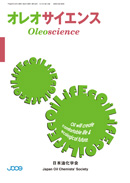
- |<
- <
- 1
- >
- >|
-
Takao FUKUOKA, Yasushige MORI2014 Volume 14 Issue 1 Pages 5-10
Published: 2014
Released on J-STAGE: February 01, 2017
JOURNAL FREE ACCESSSelf-assembled gold nanoparticles (AuNPs) are attractive issue of combination of nano structure and localized plasmon resonance (LPR) including surface enhanced Raman scattering (SERS). Anisotropic aggregation of AuNPs are typical nanostructure which are spontaneously made in colloidal dispersion and show unique SERS activity. Colloidal AuNPs are, however, intrinsically so un stable that these LPR correspond to the morphology of the aggregation are easily lost. We have achieved the stable and controllable self-assembling procedures of AuNPs by termination with charged planar nanoparticles. At the early stage of the self-assembling under diffusion limited condition, relatively simple anisotropic assembles of AuNPs of with fractal dimension of 1.4 was produced. These colloidal assembles show LPR wavelength at about 785 nm, therefore these assembles are appropriate for 785 nm SERS. More complicated aggregation is given with higher fractal dimensions following the simple anisotropic assembles. After mixing the dispersion of these AuNPs with 4,4’-bipyridine aqueous solution, SERS signal of 50 nM sample were immediately observed. The longevity in SERS activity of the pre-aggregated AuNPs dispersion was confirmed over months even in aqueous media without any surfactant or hydrophilic polymer. We also applied these assembles to label-free, quantitative and selective measurements of aqueous solution of biomolecules.
View full abstractDownload PDF (1352K) -
Tetsu YONEZAWA2014 Volume 14 Issue 1 Pages 11-15
Published: 2014
Released on J-STAGE: February 01, 2017
JOURNAL FREE ACCESSGold nanoparticles have been widely used as a good inorganic red pigment which show dark wine red color. Gold nanoparticles are considered as a long life pigment. Red stained glasses often used in old churches are old glasses containing gold nanoparticles. They are very clear and show dark red color. The history of the chemistry of gold nanoparticles is very long, and began in 1857. Faraday firstly reported the preparation of red gold hydrosol1, 2). Gold itself is a highly precious materials and show brilliant gold luster. However, gold nanoparticles show considerably different color. Gold has attracted much interest not only from scientists. Such gold nanoparticles can be prepared quite readily by chemical reduction of the corresponding salts, which also support their intensive scientific studies. Recently, Brust et al. reported the preparation of single nanometer-sized gold nanoparticles by NaBH4 reduction3). This pioneering report introduced explosive expansion of nanoparticle researches. Gold nanoclusters and gold nanocatalysts which are also invented quite recently still continue to attract the peoples’ interest. In this section, I would like to overlook the studies of gold nanoparticles.
View full abstractDownload PDF (720K) -
Takuro NIIDOME2014 Volume 14 Issue 1 Pages 17-21
Published: 2014
Released on J-STAGE: February 01, 2017
JOURNAL FREE ACCESSGold nanorods have absorption bands in the near-infrared region. The absorbed light energy is converted into heat by gold nanorods. Therefore, drug delivery systems that can be controlled by the heat produced by near-infrared light irradiation will be constructed. First, we modified gold nanorods with double-stranded DNA. That is, release of single stranded DNA is induced by the produced heat from the gold nanorods. We also constructed a controlled release system of PEG chain mediated by retro Diels-Alder reaction induced by the photothermal effect. Next, we designed transdermal protein delivery system enhanced by the photothermal effect. We first casted gold nanorods, acting as a heating device in response to near-infrared light irradiation, onto the skin surface. After applying an aqueous solution of ovalbumin to the skin, the skin was irradiated by near-infrared laser light. The irradiation increased the skin temperature resulting in an efficient translocation of ovalbumin into the skin. Thus, the controlled-release systems and enhanced transdermal protein delivery system triggered by near-infrared light irradiation will be further expanded to development of functional drug delivery system.
View full abstractDownload PDF (1075K)
- |<
- <
- 1
- >
- >|